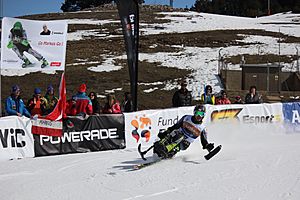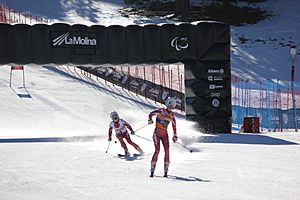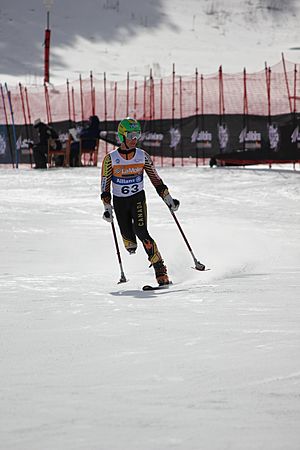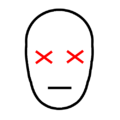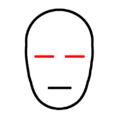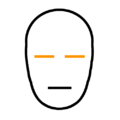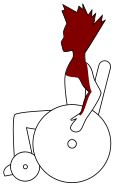Para-alpine skiing classification facts for kids
Para-alpine skiing classification is a system that helps make competitions fair for skiers with different physical abilities. It groups skiers into categories based on how their bodies are affected. This way, skiers compete against others with similar challenges.
The main groups are:
- Standing skiers: For athletes who ski standing up.
- Visually impaired skiers: For athletes who cannot see well.
- Sitting skiers: For athletes who ski in a special seat.
The International Paralympic Committee AlpineSkiing (IPC Alpine Skiing) is in charge of this system. Before them, other groups like the International Sports Organization for the Disabled (ISOD) and the International Blind Sports Federation (IBSA) helped with classification.
-
B2 skier who cannot see well
Contents
History of Para-Alpine Skiing Classification
The first classification systems for para-alpine skiing started in Scandinavia in the 1960s. These early systems were for skiers who had lost legs or arms. At first, it was hard for skiers with spinal cord injuries to ski.
The first Winter Paralympics in 1976 had only two groups for para-alpine skiing. By the 1980s, groups for skiers with cerebral palsy were added. People then tried to make the system fairer, like the classification used in wheelchair basketball.
There were ten groups by the 1980s. Since then, efforts have been made to reduce the number of classes. This helps make the competitions even better and fairer.
How Skiers are Classified
The rules for para-alpine skiing competitions are based on or adjusted from the rules of the International Ski Federation.
- Visually impaired skiers: These skiers use guides to help them ski down the mountain. The guides tell them where to go.
- Standing skiers: Rules decide what special equipment standing skiers can use. This might include one ski pole, two ski poles, no poles, or one or two skis.
- Sitting skiers: These skiers use a special ski called a mono-ski. It helps them go fast over the snow while sitting.
Skiers are placed in a group based on their medical condition and how they position their body when they ski. Visually impaired skiers are classified only by how well they can see.
Standing Skiers Classification
| Type | What it means | Equipment |
|---|---|---|
| LW 1 | Both legs amputated above the knee, or severe cerebral palsy, or similar challenge. | Two skis, two outrigger skis (small skis attached to poles for balance). |
| LW 2 | One leg amputated above the knee. | Two skis, two outrigger skis. |
| LW 3 | Both legs amputated below the knee, mild cerebral palsy, or similar challenge. | Two skis, two ski poles. |
| LW 4 | One leg amputated below the knee. | Two skis, two ski poles. |
| LW5/7-1 | Both arms amputated above the elbow. | Two skis, no ski poles. |
| LW 5/7-2 | Both arms amputated, one above and one below the elbow. | Two skis, no ski poles. |
| LW 5/7-3 | Both arms amputated below the elbow. | Two skis, no ski poles. |
| LW6/8.1 | One arm amputated above the elbow. | Two skis, one ski pole. |
| LW 6/8.2 | One arm amputated below the elbow. | Two skis, one ski pole. |
| LW9.1 | Amputation or similar challenge of one arm and one leg above the knee. | Skier can choose equipment. |
| LW9.2 | Amputation or similar challenge of one arm and one leg below the knee. | Skier can choose equipment. |
Sitting Skiers Classification (Monoskiers)
| Type | What it means |
|---|---|
| LW10.1 | Paralysis of the legs and lower body with no upper body or sitting balance. |
| LW 10.2 | Paralysis of the legs and lower body with some upper body strength but no sitting balance. |
| LW11 | Paralysis of the legs and lower body with good sitting balance. |
| LW12.1 | Paralysis of the legs and lower body with some leg movement and good sitting balance. |
| LW 12.2 | Both legs amputated above the knees. |
Visually Impaired Skiers Classification
| Type | What it means |
|---|---|
| B1 | Completely unable to see. |
| B2 | Can see very little, less than 2/60 vision. |
| B3 | Can see a little more, from 2/60 to 6/60 vision. |
Images for kids
-
Australia's Cameron Rahles Rahbula competing in the Super G at the 2012 IPC Nor Am Cup at Copper Mountain, Colorado.
-
German sit skier Anna Schaffelhuber at the 2013 IPC Alpine World Championships in La Molina, Spain.
-
Henrieta Farkasova from Slovakia at the 2013 IPC Alpine World Championships in La Molina, Spain.
-
Alexandra Frantseva, a B2 skier from Russia at the 2013 IPC Alpine World Championships at La Molina in Spain.
See also
 In Spanish: Clasificaciones paralímpicas de esquí alpino para niños
In Spanish: Clasificaciones paralímpicas de esquí alpino para niños


